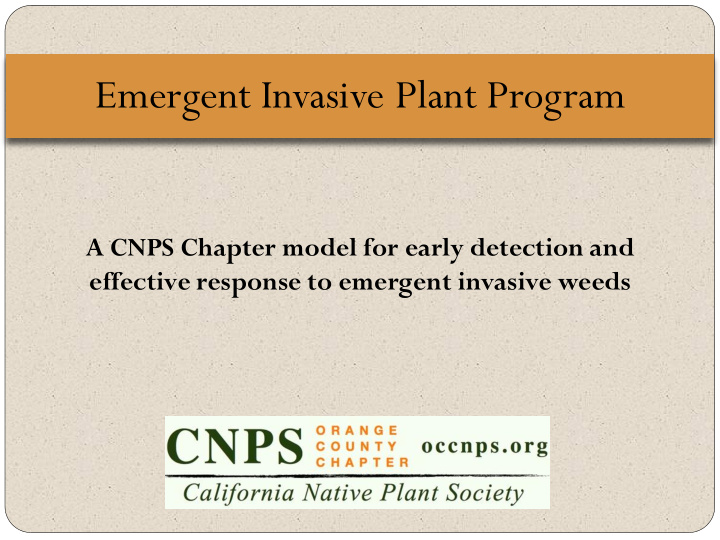



Emergent Invasive Plant Program A CNPS Chapter model for early detection and effective response to emergent invasive weeds
Emergent ent Invasive e Plant Management ement Program Many counties in California lack an effective process to identify, communicate on and coordinate the local management of emergent invasive plant species. Recent state and local funding cuts for regional programs such as Weed Management Areas have only worsened the situation.
Emergent ent Invasive e Plant Management ement Program Advantages of Regional CNPS Leadership: Unencumbered by boundaries, jurisdictions or procedural constraints Expert knowledge of the issues and plants Existing organizational structure Existing partnerships with land managers and agencies Large body of members and volunteers Ability to act quickly
Emergent ent Invasive e Plant Management ement Program Constraints of Regional CNPS: Very little budget Volunteer driven Advice, but with no authority Challenges dealing with jurisdictions
Emergent ent Invasive e Plant Management ement Program OC CNPS' response is to focus specifically on Emergent Invasive Plants Newly arrived in the region or of limited distribution High potential for invasiveness High probability of significant ecological disruption Rubus armeniacus, CalWeedMapper Our Emergent Invasives Plant List is dynamic and kept to a manageable size
Emergent ent Invasive e Plant Management ement Program Our Goal: The early detection and facilitation of the effective management of specific emergent invasive weeds within our region Early detection Communication Management support leading to a Rapid Response On-going monitoring Chrysanthemoides monilifera ssp . monilifera, Aliso Creek
Emergent ent Invasive e Plant Management ement Program Early Detection Trained “eyes on the ground” to accurately report new populations of high priority emergent weed species Hypericum canariense
Emergent ent Invasive e Plant Management ement Program Communication With our network of partners; including land managers, agencies, support groups, contractors, our members and the public
Emergent ent Invasive e Plant Management ement Program Management Support of Rapid Response Coordination with land managers, land owners, support groups and potential Brassica tournifortii, Loma Ridge labor forces Labor where needed to remove populations that may otherwise not be managed. Centaurea solstitialis, Silverado Canyon
Emergent ent Invasive e Plant Management ement Program The Plants: A dynamic list Plant candidates suggested Must qualify as emergent A data – driven review process, using scoring Highest priority plants are “Red Alert” Senecio linearifolius var. linearifolius
Emergent ent Invasive e Plant Management ement Program Knowledge Base for Plant Selection: Local knowledge Land managers Botanical consultants Active field experts Published data Other unpublished data
Emergent ent Invasive e Plant Management ement Program Scoring Protocol: Abundance Distribution Ecological Impact Rate of Spread Variables: Cal-IPC ranking/alert ID difficulty A data driven score - using objective measurements
Printable profiles for each Emergent Species
Emergent ent Invasive e Plant Management ement Program Early Success: Moroccan Knapweed ( Volutaria tubuliflora ) Second record for U.S. Site visited by OC CNPS and confirmed within 24 hours, mapped within 48 hours Aggressively and immediately managed within 10 days: By Irvine Ranch Conservancy, under contract with City of Newport Beach 3,624 plants removed CDFA adds to Noxious Weed List – A rating Media coverage and community awareness
Emergent ent Invasive e Plant Management ement Program Early Success: Sahara Mustard ( Brassica tournefortii ) 6 new emergent infestations were reported to OC CNPS 5 of these were aggressively and immediately managed: 3 by OC CNPS volunteers 1 by a cooperating land manager 1 by support group volunteers
Emergent ent Invasive e Plant Management ement Program Early Success: Yellow Star Thistle ( Centaurea solstitialis ) Three colonies in the county were mapped and plotted: Additional sub-colonies found and reported by OC CNPS Colonies now under management: By Irvine Ranch Conservancy, in cooperation with OC Parks By CA State Parks in cooperation with OC CNPS By OC CNPS volunteers By OC CNPS in cooperation with USFS 4,527 plants, plus 10 bags, removed
Emergent ent Invasive e Plant Management ement Program Early Success: Stinkwort ( Dittrichia graveolens ) First occurrence in Orange County reported by OC CNPS member. Mapped and plotted by OC CNPS within 10 days Reported to OC Parks by OC CNPS All plants removed within 60 days Cooperative effort with OC CNPS and OC Parks On-going management coordinated: Treated, under the cooperative effort of OC CNPS and OC Parks Hand pulls, under the cooperative effort of OC CNPS and OC Parks
Emergent ent Invasive e Plant Management ement Program OC CNPS Emergent Invasive Plant Management Program Relatively quick setup time Very low cost No boundaries Immediate results Engages the public Immediate Successes !!!
Emergent ent Invasive e Plant Management ement Program What’s Next? Build partnerships Train for Early Detection Add to the Cal-IPC knowledge base Encourage other chapters and regional organizations
Emergent ent Invasive e Plant Management ement Program What’s Next? Build partnerships Train for Early Detection Add to the Cal-IPC knowledge base Encourage other chapters and regional organizations Contact: Invasives@occnps.org Our site: OCCNPS.org
Recommend
More recommend